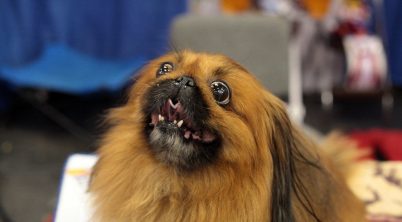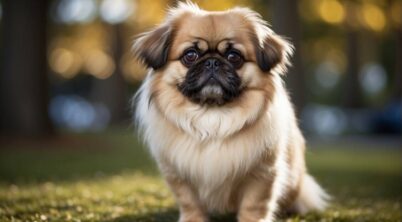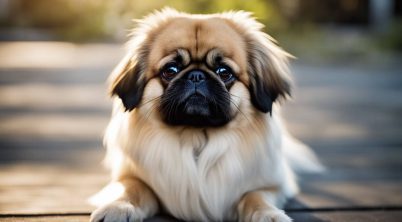The Pekingese, a dog of ancient Chinese origin, boasts a regal background intimately linked with Chinese Royalty. These dogs were once the cherished companions of the imperial Chinese court, and their history is entwined with the fabric of Ancient China. Bred to be lap dogs, the Pekingese have a distinctive appearance resembling a small lion, symbolic of their noble past. They were held in such high esteem that stealing one was punishable by death. It wasn’t until the Opium Wars in the mid-19th century, and the subsequent looting of the Summer Palace, that the breed became known in the West, with several of them being presented to Queen Victoria.
Shaped by their history, Pekingese maintain a dignified and confident composure, requiring an environment that suits their royal lineage. Despite their small size, Pekingese are sturdy and independent dogs with a charismatic charm that endears them to their owners. Ideal living conditions cater to their physical and behavioral needs, including their propensity for self-important behavior and their moderate exercise requirements. These dogs thrive in settings where they can receive the adoration they were historically accustomed to, mirroring the luxurious confines of Chinese palaces.
Adaptability is a hallmark of the Pekingese, allowing them to adjust to various living environments. While they are content in smaller spaces such as apartments, their living space must provide comfort and warmth to keep them happy and healthy. Due to their heavy coat and shortened snouts, they are sensitive to extreme temperatures, with a preference for cooler environments. Attention to their unique requirements ensures that the Pekingese continues to live as royally as it did within the walls of China’s ancient dynasties.
Table of Contents
Temperament and Socialization
The Pekingese is a breed with a complex temperament, characterized by its intelligence and affectionate nature, while also displaying independence and stubbornness. They benefit greatly from early and consistent socialization to develop into well-rounded pets.
Nature and Personality
The Pekingese breed exhibits a bold and courageous personality, often appearing more confident than their small stature might suggest. They are loyal and affectionate towards their families, and though they may be independent, they form strong bonds with their owners. Despite their size, they are alert and can be protective of their home, making them good little watchdogs.
Training and Intelligence
Pekingese dogs are intelligent and can learn commands, but they may show stubbornness during training. Consistent and patient training methods work best, as the breed responds well to positive reinforcement. To mitigate their stubborn tendencies, it’s crucial to establish a routine and use engaging training techniques that stimulate their minds.
- Training tip: Always use positive reinforcement such as treats and praise to encourage your Pekingese during training sessions.
Socialization Needs
Early socialization is essential for the Pekingese, introducing them to a variety of people, sounds, and experiences. They are typically playful with family members but might be wary around strangers or other pets. It’s important for them to interact with different environments and individuals to prevent potential behavior issues. Regular, gentle socialization helps them become well-adjusted and less prone to anxiety in new situations.
- Socialization strategy: Start introducing your Pekingese to new experiences at a young age, always ensuring interactions are positive and non-threatening.
Living Environment
The Pekingese thrives in a living environment that accommodates its moderate energy level and need for regular exercise. Owners should ensure a cool atmosphere to prevent the breed from overheating, especially in hot weather. These dogs can adapt to apartment living if their specific needs are met.
Suitable Homes
Pekingese are well-suited to living in apartments as much as in homes with yards, as long as they are provided with a cool environment to avoid heat stress. Their relatively calm demeanor makes them excellent companions for indoor living. However, they still require:
- Ample space for daily activities
- Protection from excessive heat to prevent overheating
- Access to a cool and comfortable resting area
It’s important for these dogs to have a quiet corner of their own as they appreciate having a safe retreat.
Exercise and Play
Regular exercise is critical to maintaining the Pekingese’s health and happiness. Exercise should be tailored to avoid their overheating in hot weather. These dogs exhibit bursts of playful energy that can be satisfied with:
- Short, daily walks in cooler parts of the day
- Indoor playtime with toys
- Gentle play sessions to prevent joint stress
Despite their small stature, Pekingese enjoy being active and need to engage in regular exercises to manage their energy levels. As they make excellent watchdogs, interactive games that stimulate their alertness can also be beneficial.
Diet and Care
A balanced diet is crucial for a Pekingese’s health. They should consume high-quality proteins and essential fats, while their intake of easily digestible carbohydrates should be moderate. Feeding them nutrient-rich food supports their energy levels and overall well-being.
Proper Diet
- Proteins: Chicken, Lamb, Fish
- Carbohydrates: Brown rice, Sweet potatoes
- Fats: Omega-3 rich oils like fish oil
- Vitamins & Minerals: Found in commercial dog foods or as advised by a vet
Obesity can be a concern for the Pekingese; hence, portion control and limited treats are important. Treats should not exceed 10% of their daily caloric intake.
Health Considerations
- Heart: A diet low in sodium to support cardiovascular health.
- Eyes & Knees: Regular check-ups to monitor for common issues like patellar luxation and eye conditions.
- Brachycephalic Needs: They may have difficulties with breathing and overheating due to their short muzzles.
Regular exercise tailored to their capabilities helps maintain a Pekingese’s weight and health. Short walks are preferable, as they are prone to overheating because they are brachycephalic. Brachycephalic breeds like the Pekingese often exhibit snoring or labored breathing.
While not overly energetic, these dogs appreciate light exercises like:
- Morning or evening walks to prevent overheating
- Play sessions that stimulate their mind and body
As watchdogs, Pekingese can be alert without the need for rigorous activity. Their care routine should also include:
- Trust-based training and socializing activities
- Grooming to prevent coat tangling and matting, which also provides the opportunity to check for skin issues








